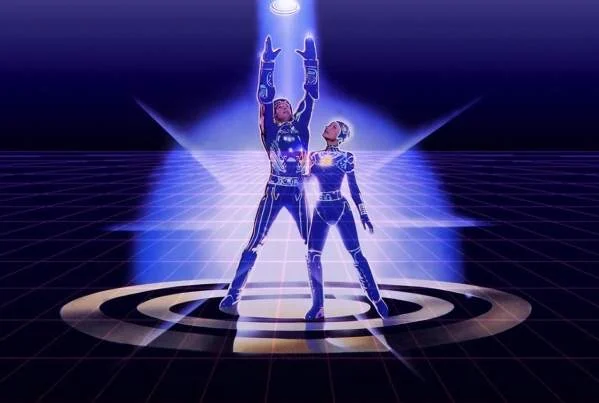Like with many great films, the stories behind the scenes can be just as entertaining as the movies themselves.
The origins of Tron can actually be traced all the way back to the late 70’s. Writer/director Steve Lisberger had his own animation studio, Lisberger Films, back in Boston. A graduate of the city’s School of the Museum of Fine Arts, he was creating animation regularly for networks such as ABC and PBS, but kept his eyes on a much bigger prize.
“When you have an animation studio you try to create your Mickey Mouse,” Lisberger says. “It’s no secret that animation studios survive by creating characters who are their actors they own, and we were a team of people in Boston who wanted to create a character.”
On Lisberger’s team were Roger Allers, who went on to direct The Lion King, and John Norton. Norton came up with an idea of a warrior who was made of neon. They called him Tron, but they didn’t have a setting for him. Then one night Lisberger went to visit his in-laws, and everyone was crouched around the TV, playing Pong.
“They kept referring to the games, ‘play the game,’ and since I had been working on a project called Animalympics, the idea of games to me meant more than that, it meant Olympic or gladiatorial games. Then I thought, ‘Well, our warrior should be in a gladiatorial game setting.’ From there the whole thing started to snowball.”
Ultimately Tron would be about human characters who are sucked into, and have to fight their way through, a computer animated video game world.

Lisberger Films was originally going to make Tron themselves. They had just finished Animalympics, a spoof on the Olympic games with animated animal athletes (Billy Crystal, Gilda Radner and Harry Shearer provided the voices).
It was going to run in segments during the 1980 Olympics between athletic events, but when America boycotted the games, the project fell apart and Lisberger Films no longer had the financial means to make Tron in-house. They reportedly took Tron to Warner Brothers, MGM and Columbia, who all turned it down, before it wound up at Disney.
Science fiction films that are heavily visual are often a tough sell. When George Lucas tried to set up Star Wars, he had a hard time drumming up any interest because it was completely unintelligible in treatment form. The Wachowski Brothers reportedly had to create extensive graphic novel style storyboards for The Matrix before Warner Brothers really got it. When Lisberger and company went out to sell Tron, they were ready.
“We had hundreds and hundreds and hundreds of thousands of dollars invested in the project when we went to Disney,” he says. “We had it storyboarded, we had designs, we had budgets, we had staff, we had schedules, we had sample reels, I mean we had everything but money.”
Tron had a strong ally in Tom Wilheit, then the head of Disney’s film division, who Lisberger calls a visionary. “Tom believed Tron was going to establish Disney as a force beyond the Herbie movies. The powers that be at the studio really resented the film with all these young conjurers, and Wilheit was looked down upon by the old Disney guard. But he took a shot on something really crazy during the brief time he ran the studio. He also was the one who was responsible for bringing Roger Rabbit into Disney.”
Computer effects were being pitched to the major studios as far back as the 70s, but no one was interested. The CGI revolution was still far away and Disney hoped it would stay that way.
”When we were making the movie at Disney, people used to hold up crosses when Tron walked through the halls,” Lisberger recalls. “We were the undead. We were making a film that was from the netherworld. They were just very afraid. This was the future and it was rolling down the most conservative linoleum hallways on the earth.”
Disney was stuck in the past and just couldn’t move with the times. Their last live action hit at the time was apparently The Love Bug. Lisberger recalled two geriatric Disney executives arguing about the dearth of good live action films at the studio. One said they should have made E.T., and the other shot back, “We made E.T., it was called The Cat From Outer Space!”
Lisberger had a hell of a time casting the film because Disney’s rep was so bad that an agent only sent their actors there if The Love Boat was on hiatus.
”Back then if you told people you were trying to cast a Disney movie back they’d just hung up on you,” he says. They just didn’t want to know. Everybody was just fixated on: ‘You can’t work for Disney, no one works for that studio.'”
Yet the under-rated and always dependable Jeff Bridges clearly didn’t care about the politics involved; he wanted to do the movie, pure and simple. “This sounds far out,” he told Lisberg. And as we saw by the end result, indeed it was.
Although it wasn’t a critical or box office success when it first came out, Tron lives on strong today, and the fans who first saw it in the theaters, like myself, didn’t need to wait thirty years to realize how cool it was. ”God bless the kids, their minds are open,” Lisberg says. “Tron was their story because those kids were the ones, like Jeff Bridges, who went into cyberspace.”






